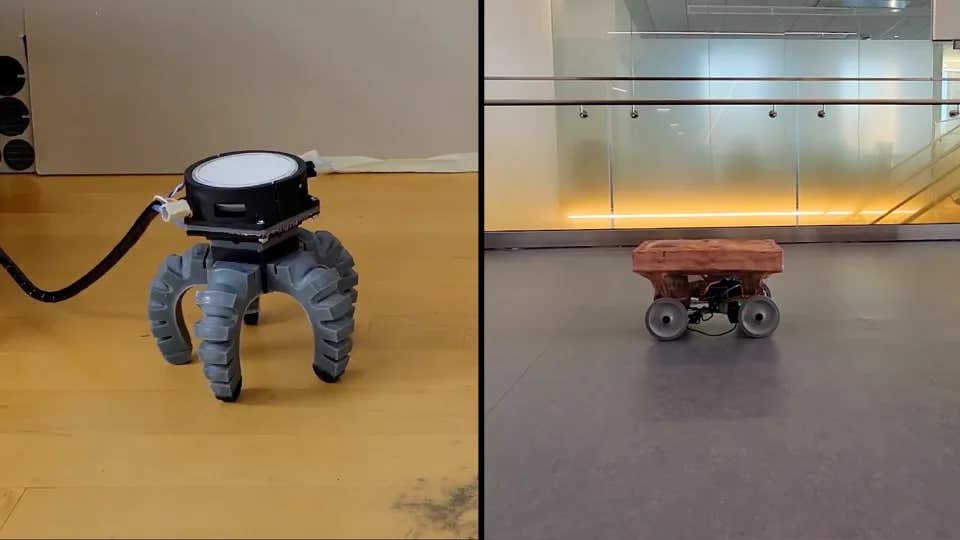Star Trek discovery: Scientists create the first mycelial-driven biohybrid robots
In Star Trek: Discovery, the Spore Drive is depicted as a form of faster-than-light travel that uses a network of subspace “mycelial” spores to navigate through space.

This novel approach could enable robots to respond to their environment with greater sophistication. (CREDIT: Cornell University)
In Star Trek: Discovery, the Spore Drive is depicted as a form of faster-than-light travel that uses a network of subspace "mycelial" spores to navigate through space.
In what could be the first step from science fiction to science fact, a team of scientists from Cornell’s Organic Robotics Lab incorporated fungal mycelia, a substance typically found on the forest floor, into the design of new biohybrid robots. Starting as spores, fungi grow into mycelium, which then generate mushrooms that in turn produce more spores, beginning the cycle anew.
The key to this innovation lies in the natural electrical signals generated by mycelia, which the researchers harnessed to control these robots. This novel approach could enable robots to respond to their environment with greater sophistication than traditional, purely synthetic robots.
The research, detailed in the paper "Sensorimotor Control of Robots Mediated by Electrophysiological Measurements of Fungal Mycelia," was published in Science Robotics. Anand Mishra, a research associate in Cornell’s Organic Robotics Lab, led the study, with Rob Shepherd, a professor of mechanical and aerospace engineering, serving as the senior author.
According to Shepherd, "This paper is the first of many that will use the fungal kingdom to provide environmental sensing and command signals to robots to improve their levels of autonomy." By embedding mycelium into the electronic systems of a robot, the team enabled the biohybrid machine to detect and react to environmental changes.
For their initial experiments, they used light as the stimulus, but they anticipate that future versions could respond to chemical inputs as well. Shepherd envisions robots equipped with these capabilities being used in agriculture, for instance, where they could monitor soil chemistry and determine the optimal timing for fertilizer application. Such advancements could potentially reduce the environmental impact of farming, such as the occurrence of harmful algal blooms.
In the quest to build the robots of the future, engineers often look to the animal kingdom for inspiration. Machines that imitate the movements, sensory systems, and even the internal temperature regulation of living creatures have been developed. Some have even incorporated living tissues, such as muscle cells, into their designs.
Related Stories
However, maintaining these complex biological systems within a robot poses significant challenges, including the difficulty of keeping them functional over time. Mycelia, on the other hand, present a compelling alternative.
Mycelia are the underground, vegetative structures of fungi, and they offer several advantages for biohybrid robots. They are capable of growing in harsh conditions, and they have an inherent ability to sense and respond to chemical and biological signals. Unlike synthetic sensors, which are typically designed for a single purpose, living systems like mycelia can respond to a wide range of stimuli, including light, heat, and even unknown signals.
Mishra explains, “If you think about a synthetic system—let’s say, any passive sensor—we just use it for one purpose. But living systems respond to touch, they respond to light, they respond to heat, they respond to even some unknowns, like signals. That’s why we think, OK, if you wanted to build future robots, how can they work in an unexpected environment? We can leverage these living systems, and any unknown input comes in, the robot will respond to that.”
However, integrating mushrooms with robots is no simple task. It requires a diverse skill set that spans multiple disciplines.
“You have to have a background in mechanical engineering, electronics, some mycology, some neurobiology, some kind of signal processing,” Mishra notes. “All these fields come together to build this kind of system.”
To develop this system, Mishra collaborated with a diverse group of experts. Bruce Johnson, a senior research associate in neurobiology and behavior, helped him understand how to record the electrical signals carried by neuron-like ionic channels in the mycelia membrane.
Meanwhile, Kathie Hodge, an associate professor of plant pathology and plant-microbe biology, taught him how to cultivate clean mycelia cultures. This step was crucial because contamination can be a significant issue when inserting electrodes into fungus.
The system that Mishra and his team developed includes an electrical interface designed to block out vibrations and electromagnetic interference, allowing them to accurately record and process the mycelia’s electrophysiological activity in real-time.
This data is then fed into a controller inspired by central pattern generators, a type of neural circuit. The system reads the raw electrical signals, identifies the mycelia’s rhythmic spikes, and converts this information into digital control signals that direct the robot’s actuators.
The team built two biohybrid robots to demonstrate this technology: one, a soft robot shaped like a spider, and the other, a wheeled bot.
The robots were tested in three experiments. Initially, they moved—walking and rolling in response to the natural continuous spikes in the mycelia’s signals. Next, the researchers exposed the robots to ultraviolet light, which caused them to alter their movement patterns, showcasing mycelia’s ability to react to environmental stimuli. Finally, the researchers demonstrated that they could override the mycelia’s native signals entirely, controlling the robots directly.
The implications of this research extend far beyond robotics and mycology.
“This kind of project is not just about controlling a robot,” Mishra emphasizes. “It is also about creating a true connection with the living system. Because once you hear the signal, you also understand what’s going on. Maybe that signal is coming from some kind of stresses. So you’re seeing the physical response, because those signals we can’t visualize, but the robot is making a visualization.”
The interdisciplinary nature of this work is reflected in the diverse team of co-authors, including Johnson, Hodge, Jaeseok Kim from the University of Florence, and undergraduate research assistant Hannah Baghdadi.
The research was supported by several institutions, including the National Science Foundation (NSF) CROPPS Science and Technology Center, the U.S. Department of Agriculture’s National Institute of Food and Agriculture, and the NSF Signal in Soil program.
This pioneering work not only opens up new possibilities for robotics but also suggests that the fungal kingdom may hold untapped potential for developing responsive, adaptable technologies that bridge the gap between the biological and mechanical worlds.
Note: Materials provided above by The Brighter Side of News. Content may be edited for style and length.
Like these kind of feel good stories? Get The Brighter Side of News' newsletter.



